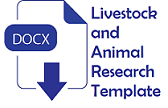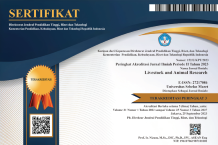Pengaruh perbedaan rasio menir kedelai proteksi dan tanpa proteksi terhadap konsumsi, kecernaan dan nilai nutrien pakan Domba Ekor Gemuk
Abstract
Tujuan: Penelitian ini bertujuan untuk menguji pakan penggemukan Domba Ekor Gemuk (DEG) ditinjau dari aspek konsumsi, kecernaan dan efisiensi penggunaan nutrien.
Metode: Pakan penelitian menggunakan konsentrat mengandung menir kedelai tanpa proteksi dan terproteksi menggunakan formaldehid kadar 37%. Domba penelitian sebanyak 15 ekor dibagi dalam tiga macam perlakuan masing-masing perlakuan diulang satu kali menggunakan satu ekor DEG setiap ulangan. Perlakuan terdiri dari P1 = 30% rumput gajah (RG) + 55% konsentrat basal (KB) + 10% menir kedelai tanpa terproteksi (MKTP) + 5% menir kedelai proteksi (MKP), P2 = 30% rumput gajah (RG) + 55% konsentrat basal (KB) + 7.5% menir kedelai tanpa terproteksi (MKTP) + 7.5% menir kedelai proteksi (MKP), dan P3 = 30% rumput gajah (KB) + 55% konsentrat basal (KB) + 5% menir kedelai tanpa terproteksi (MKTP) + 10% menir kedelai proteksi (MKP). Parameter meliputi konsumsi, kecernaan dan efisiensi penggunaan nutrien bahan kering, bahan organik dan protein kasar.
Hasil: Hasil penelitian menunjukan bahwa perbedaan perlakuan berpengaruh nyata terhadap konsumi, kecernaan dan protein kasar dapat dicerna (P>0,05) dan tidak berpengaruh terhadap konsumsi dan kecernaan bahan kering dan bahan organik serta bahan kering dan bahan organik tercerna (P<0,05). Kecernaan protein kasar P1, P2 dan P3 berturut-turut 72,33%, 75,17%, dan 77,13%.
Kesimpulan: Pakan P3 untuk penggemukan DEG dihasilkan konsumsi dan kecernaan protein kasar yang lebih tinggi dan efisien dari pada P1.Keywords
Full Text:
PDFReferences
Wibowo, M. S., M. D. Efendi, S. D. Widyawati, Lutojo, J. Riyanto, dan W. P. S. Suprayogi. 2012. Pengaruh Suplementasi Minyak Ikan Lemuru dan Minyak Kelapa Sawit Terproteksi dalam Ransum terhadap Performan dan Kualitas Kimia Daging Domba Lokal Jantan. Tropical Animal Husbandry 1 (1): 67-74.
Riyanto, J., Sudibya, and S. J. Anhardhika. 2019a. Influence of Soybean Groats Protected Used in The Consumption and Digestibility of Dry Matter, Organic Matter and Crude Protein on The Bligon Goats IOP Conf. Series: Earth and Environmental Science 372 (2019) 012059.
Riyanto, J, and Sudibya. 2018. Evaluation of Feeds Thin-Tailed Sheep Profile with Supplemented Protected and Unprotected Aldehyde. IOP Conference Series: Earth and Environmental Science 102 (1): 012011. Doi: 10.1088 / 1755-1315 / 119/1/012020.
Stanton, T. L., F. N. Owens, and K. S. Lusby. 1983. Formaldehyde-treated soybean meal for ruminants winter range grass grazing. J. Anim. Sci, 56: 6-14.
Mahadevan, S., R. M. Theather, J. D. Erfle, and F. D. Sauer. 1983. Effect of formaldehyde treatment on soybean meal on rates of protein degradation and microbial protein concentration in bovine rumen. Can. J. Anim. Sci. 63: 181-190.
Fiems, L. O., Cottyn, B. G., Boucqué, C. V., and Buysse, F. X. 1987. Effect of formaldehyde-treated soya bean meal and urea in starters on nitrogen quality, degradability in sacco, sheep digestibility and calf performance. Anim. Feed Sci. Technol., 16(4): 287-295.
Nobar, R. S. 2011. Ruminal dry matter degradation of soybean meal as source of escape protein. African J. Biotech. 10 (41): 8090-8092.
Riyanto, J., S D Widyawati, W. P. S. Suprayogi, and A. K. Wati. 2019b. The Use of Saponification of Animal and Vegetable Oils in The Rations on The Physical Quality of Sheep Meat on Bicepsfemoris Muscles IOP Conf. Series: Earth and Environmental Science 372 (2019) 012026.
Suhartanto, B., Utomo, R., Kustantinah, Budisatria, I. G. S., Yusiati, L. M., and Widyobroto, B. P. 2014. The effect of formaldehyde inclusion on undegraded protein processing and its supplementation level on complete feed pellet on in vitro rumen microbial activities. Bul. Peternakan, 38(3): 141-149.
Palizdar, M. H., H. Sadeghipanah, H. Amanlou, H. R. Mohammadian-Tabrizi, and A. Mirhadi. 2012. Effect of soybean meal coated with fat on in vitro organic matter fermentation and gas production. J. Anim. and Vet. Adv, 11 (2): 171-180.
Thatcher, W. W., and C. R. Staples. 2000. Effects of dietary fat supplementation on reproduction in lactating dairy cows. Adv. in Dairy Tech. 12: 213 – 232.
Jenkins, T. C., R. J. Wallace, P. J. Motae, and E. E. Mosly. 2008. Board-invited review : Recent advances in biohydrogenation of saturated faty acids within the rumen microbial ecosistem. J. Anim. Sci. 86:397-412.
Stanton T. L., F. N. Owens, and K. S. Lusby. 1983. Formaldehyde-treated soybean meal for ruminants grazing winter range grass. J. Anim. Sci; 56:6-14.
Wonnacott, K. E., W. Y. Kwong, J. Hughes, A. M. Salter, R. G. Lea, P. C. Garnsworthy, and K. D. Sinclair. 2010. Dietary omega-3 and -6 polyunsaturated fatty acids affect the composition and development of sheep granulosa cells, oocytes and embryos. Reproduction 39: 57 - 69.
Lourenc¸ M., E. Ramos-Morales, and R. J. Wallace. 2010. The role of microbes in rumen lipolysis and biohydrogenation and their manipulation. Animal (2010), 4 (7): 1008–1023 & The Animal Consortium 2010.
Oldham, J. D., I. C. Hart, and J. A. Bines. 1982. Formaldehide-treated proteins or dairy cows-effects on blood hormone concentration. Er. J. Nutr. 48: 543-547.
Tyagi, N., S. S. Thakur, and S. K. Shelke., 2010. Effect of bypass fat supplementation on productive and reproductive performance in crossbred cows. Trop. Anim. Health Prod. 42: 1749 - 1755.
Wallace J. M. W., McCabe A. J., Robson, P. J., Keogh, M. K., Murray, C. A., Kelly, P. M., Marquez-Ruiz, G., McGlynn, H., Gilmore, W. S., and J. J. Strain. 2000. Bioavailability of n-3 polyunsaturated fatty acids (PUFA) in foods enriched with microencapsulated fish oil. Annal. of Nut. and Met. 44: 157 - 162.
Santos, J. E. P., T. R. Bilby, W. W. Thatcher, C. R. Staples, and F. T. Silvestre. 2008. Long chain fatty acids of diet as faktors influencing reproduction in cattle. Reprod. in Dom. Anim. 43: 23 - 30.
Lopes, C. N. A. B. Scarpa, B. I. Cappellozza, R. F. Cooke, and J. L. M. Vasconcelos. 2009. Effects of rumen-protected polyunsaturated fatty acid supplementation on reproductive performance of Bos indicus beef cows. J. Anim. Sci. 87: 3935 – 3943.
Refbacks
- There are currently no refbacks.










